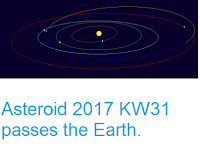Asteroid 2017 NS5 passed by the Earth at a distance of about 5 136 000
km (13.4 times the average distance between the Earth and the Moon, or 3.43% of the distance between the Earth and the Sun), at about 8.10
am
GMT on Monday 17 July 2017. There was no danger of
the asteroid hitting us, though were it to do so it would have
presented a considerable threat. 2017 NS5 has an estimated
equivalent
diameter of 138-410 m (i.e. it is estimated that a spherical object with
the same volume would be 138-410 m in diameter), and an object of this
size would be predicted to be capable of
passing through the Earth's
atmosphere relatively intact, impacting the ground directly with an
explosion that would be 3000-165 000 times as powerful as the
Hiroshima
bomb. Such an impact would result in an impact crater 2-7 km in
diameter
and devastation on a global scale, as well as climatic effects that
would last decades or even centuries.
2017 NS5 was discovered on 10 July 2017 (seven days before its closest approach to the Earth) by the University of Hawaii's PANSTARRS telescope on Mount Haleakala on Maui. The designation 2017 NS5 implies that it was the 143rd asteroid (asteroid S5) discovered in the first half of July 2017 (period 2017 N).
See also...
Image of 2017 NS5 taken with the iTelescope T17 Deep Field Research Telescope at Siding Spring Observatory in New South Wales on 11 July 2017. The image is a composite of six fifty second exposures, the dotted lines being stars which have moved over the course of the exposures and the asteroid the faint object inset indicated by the arrow. Marian Urbanik/iTelescope/Fotografický občasník.
2017 NS5 was discovered on 10 July 2017 (seven days before its closest approach to the Earth) by the University of Hawaii's PANSTARRS telescope on Mount Haleakala on Maui. The designation 2017 NS5 implies that it was the 143rd asteroid (asteroid S5) discovered in the first half of July 2017 (period 2017 N).
The calculated orbit of 2017 NS1. Minor Planet Center.
2017 NS1 has a 353 day orbital period, with an elliptical orbit tilted at
an angle of 44.0° to the plain of the Solar System which takes in to
0.72 AU from the Sun (72% of the distance at which the Earth orbits the
Sun; slightly inside the orbit of the planet Venus) and out to
1.23 AU (23%
further away from the Sun than the Earth). This means that close
encounters between the asteroid and Earth are fairly common, with the
last thought to have happened in July 2016 and the next predicted
in July 2018. 2017 NS1 also has occasional close encounters with the
planet Venus, with the next predicted for February 2148. Although it does cross the Earth's
orbit and is briefly
further from the Sun on each cycle, 2017 NS1 spends most of its time
closer to the Sun than we are, and is therefore classified as an Aten
Group Asteroid. As an asteroid probably larger than 150 m in diameter
that occasionally comes within 0.05 AU of the Earth, 2017 NS1 is also
classified as a Potentially Hazardous Asteroid.
See also...
Follow Sciency Thoughts on Facebook.








